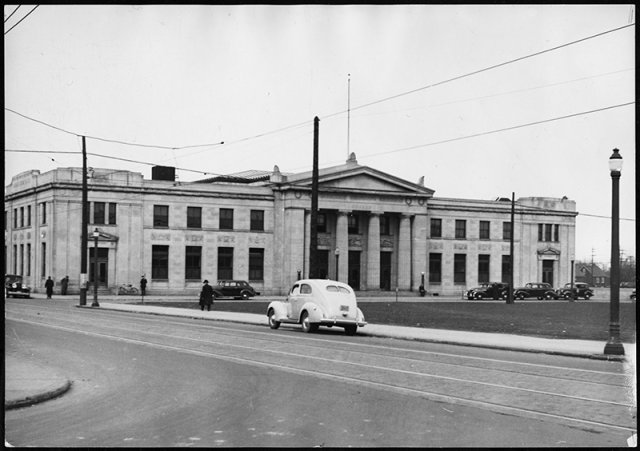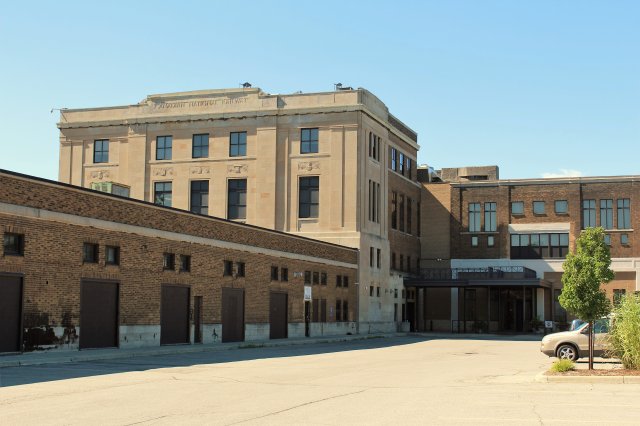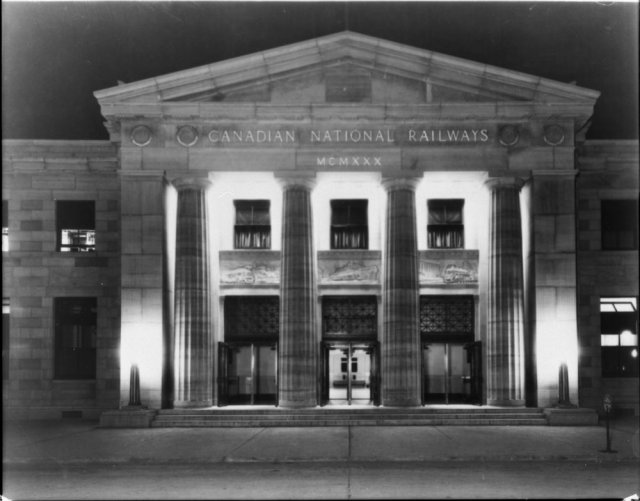
Image Credit: Library and Archives Canada
Architectural Credit: John Schofield (C.N.R. Corporate Architect); Renovation and Adaptive Reuse by Architect John Mokrycke, Lintack Architects
Location: Hamilton, ON
Architects: John Schofield (C.N.R. Corporate Architect); Renovation and Adaptive Reuse by John Mokrycke Architect, Lintack Architects
Date of completion: 1931
Nominated by: Andrea Horwath, MPP (Hamilton Centre)
Built between 1929 and 1931 by the Canadian National Railway in order to provide the booming city with a large and efficient central train station, the Hamilton C.N.R. Station- now known as LIUNA Station- stands as a reminder of the importance of the railway in the early prosperity of this industrial city, while acting as a beacon of new economic opportunities latent in the adaptive reuse of our industrial heritage.

[Front entrance to the] Canadian National Railway Station, Hamilton. [193-] (C 7-3, B117500; John Boyd numbered photographs), Archives of Ontario
Its Beaux-Art design is the work of C.N.R. corporate architect John Schofield, who was responsible for the design of some of C.N.R.’s most iconic stations and hotels including the Bessborough Hotel in Saskatoon and the Hotel Vancouver in British Columbia. Guided by CN.R. corporate policy, the station uses – nearly exclusively – local materials and labour. Most distinctively, the façade is clad in Queenston limestone and the back building is made of local brown brick.
 The three masses of Queenston limestone and Ontario brown brick. Photo Credit: Adam Tracey
The three masses of Queenston limestone and Ontario brown brick. Photo Credit: Adam Tracey
[Train platforms of the] Canadian National Railway Station, Hamilton. [193-], (C 7-3, B117500; John Boyd numbered photographs), Archives of Ontario
The complex consists of three masses, each distinct in form and materials. Its most distinguishing structure is the impressive limestone clad, Beaux-Arts main station building, dominated by a central entrance portico with four massive columns. Embedded into the façade are beautiful stone bas-relief carvings by Dutch Canadian artist William Oosterhoff - one of the few elements in the station’s design that reflect the popular art deco movement and capture the relationship between industry and the railway.

Bas-relief carvings by William Oosterhoff, Photo Credit: Adam Tracey
Erected along the city’s oldest rail corridor at a time of great economic need in Canada, the Hamilton C.N.R. station rose as symbol of economic success and optimism and it served as an important boost to the local economy. In the early 1930s, the C.N.R. employed, directly and indirectly, over 10,000 people in Hamilton – roughly eight percent of the population. Its construction also supported many local businesses, including the local limestone quarry at Queenston, Ontario brick manufacturers, and Canadian artists who added various bas-relief stone panels to the building’s façade.

Hamilton C.N.R. Station, c.1930's Photo Credit: Canada. Dept. of Interior / Library and Archives Canada / PA-043462
With the rise of the highway, and the consolidation of GO Transit and VIA Rail service to alternate transit nodes, the station suffered a steady decline of passengers which ended with its official closure in 1993. The station sat vacant for a number of years but found new use as a movie set, including the set for The Long Kiss Goodnight staring Samuel L. Jackson and the 2000 scene of a battle between the X-Men and Magneto’s forces. In 2000, the Labourer’s International Union of North America bough the vacant station and with the help of architect John Mokrycke transformed the building into LIUNA Station, an events centre for weddings, dances and other special events. In 2010, Lintack Architects renovated the track level space to create the King George Ballroom, a premiere ballroom and conference facility.
 Photo Credit: Adam Tracey
Photo Credit: Adam Tracey
Today, LIUNA Station is one of the many buildings in Hamilton that are proving the value of adaptive reuse – utilizing our industrial architectural heritage to respond to our 21st century needs.
This post forms part of our World Architecture Day Queen’s Park Picks 2017 series in which we asked Ontario’s Members of Provincial Parliament to nominate a prominent building, past or present, in their riding for a chance to learn more about it. Check out the rest of the series to learn more about Ontario’s great
architecture.